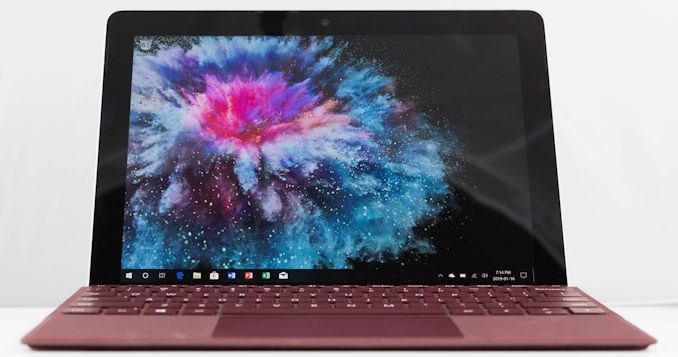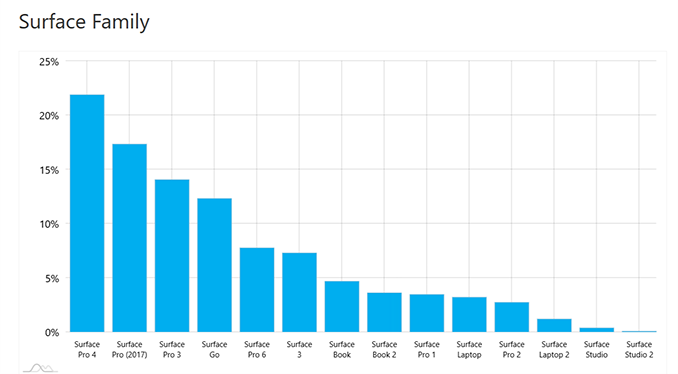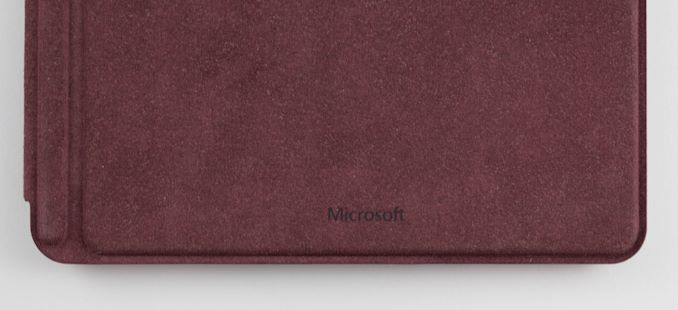The Microsoft Surface Go LTE Review: Unmatched Mobility
by Brett Howse on January 17, 2019 8:00 AM EST
Microsoft’s Surface Pro lineup has been a design win for the company for several years now. The Surface Go was launched in July of 2018 as a lower-cost version of the Surface Pro, offering buyers a less expensive way to become a Surface customer, and by the nature of its smaller size compared to the Surface Pro, an even more portable convertible Surface tablet. When the device was initially announced, a model with LTE connectivity was also in the works, and the Surface Go LTE arrived in November 2018.
Featuring a 10-inch display, the Surface Go is quite a bit smaller than the Pro, and the obvious comparison to make would be against the Surface 3, which launched way back in 2015. In the three year gap between these models, Microsoft had seemed to abandon the idea of the smaller convertible tablet in their lineup. But thanks to the smaller price tag, it was always a popular model, and it is great to see them reintroduce the reduced size Surface again. Even though the Surface 3 launched way back in 2015, it still has a usage share higher than any Surface launched outside of the Pro models, and now the Surface Go.

Source: AdDuplex.com
Looking at numbers from AdDuplex from December 2018, it makes it clear why the Surface Go was launched. And despite it only being on the market for about five months, it’s clearly gained a lot of traction in the Surface market, with usage share outstripping that of every other non-Pro model ever launched. We never got a chance to review the original Surface Go, but Microsoft has sent us the Surface Go LTE model for a full review.
The Surface Go LTE offers the benefit of always-on connectivity – assuming you have cellular coverage of course – and this opens it up to an even wider audience of customers. Microsoft is clearly aiming the Surface Go LTE at business customers looking for a small device they can take on-site, with an even smaller footprint than the Surface Pro LTE, and a lighter form factor. As has been the case with the last couple of LTE variants for Surface, the Surface Go LTE utilizes a Qualcomm X16 modem.
The rest of the Surface Go is unchanged. It’s still powered by the dual-core Intel Pentium 4415Y processor, and has the same 10-inch 1800x1200 3:2 PixelSense display. The only real difference is that the LTE variant is only available with 8 GB of RAM and 128 GB of SSD storage. The 4 GB / 64 GB eMMC model cannot be purchased with LTE.
| Microsoft Surface Go | |||||
| Surface Go Specifications | |||||
| CPU | Intel Pentium Gold 4415Y (Kaby Lake-Y) 2 core, 4 thread, 1.6 GHz base frequency |
||||
| GPU | Intel HD 615 24 EUs 850 MHz boost frequency |
||||
| Display | 10-inch PixelSense 1800x1200 3:2 aspect 216 Pixels Per Inch 10-point Multitouch Surface Pen support |
||||
| Dimensions | 245 x 175 x 8.3 mm 9.6 x 6.9 x 0.33 inches |
||||
| Weight | 522 grams (WiFi) / 532 grams (LTE) 1.15 lbs (WiFi) / 1.17 lbs (LTE) |
||||
| RAM | 4 or 8 GB LPDDR3-1866 | ||||
| Storage | 64 GB eMMC 128 NVMe SSD optional 256 GB NVMe SSD (Commerical Option) |
||||
| Wireless | 802.11ac with Bluetooth 4.1 Qualcomm Snapdragon X16 LTE Optional |
||||
| Battery | Up to 9 hours of video playback 24W Charger |
||||
| Cameras | Windows Hello IR camera 5 MP Front Camera with 1080p video 8 MP Rear Camera with 1080p video |
||||
| Ports | USB Type-C 3.1 Gen 1 with power delivery Surface Connect MicroSD Headset |
||||
| Price | 4GB/64GB $399 4GB/128GB $499 8GB/128GB $549 8GB/128 GB LTE $679 Windows 10 Pro $50 extra |
||||
The Surface Go offers many of the same features as its larger siblings, including the Surface Connect port for charging and data. This is a big upgrade over the Surface 3, which only offered micro USB charging, and the Surface Go ships with a 24-Watt AC adapter. The advantage for business customers here is that the Surface Go will work with the same Surface Dock as the rest of the lineup, meaning it can easily be connected to power, displays, and Ethernet on the desk, and then with one magnetic connector, becomes instantly portable.
The Surface Go also offers USB Type-C, which is a huge advantage for the Surface Go compared to the Surface Pro, since you can use any Type-C charger while on the road with the Surface Go. It does lose the USB Type-A port that is a key feature of the Surface Pro, but on a portable device like this, that is a worthwhile trade-off. If you need Type-A, you can of course get an adapter for Type-C, or use the Surface Dock.
It's been quite remarkable to see just how popular this device is in the market, despite it only being available for a few months. Let’s dig into the Surface Go LTE.











79 Comments
View All Comments
Zeratul56 - Sunday, January 20, 2019 - link
Not everyone can afford multiple devices or even want maintain more than one. While the Go is worse in several areas compared to the ipad(battery, performance) it makes up for it in capabilities.At least in my perspective, the iPad doesn’t do enough to justify its purchase. I had one a few years ago and it was nice but it doesn’t do anything more than an iPhone can.
gglaw - Thursday, January 17, 2019 - link
I honestly can't see why anyone would buy this other than for business with strict requirement for LTE which cost-wise is well out of the budget market for the LTE models. I travel light with an aging Lenovo Miix 510 which is a convertible 12" and it is small *enough* without being severely crippled. Unless that little bit of extra size is just a complete deal breaker, it goes for $500-$550 range for the base i5-7200U and 128GB SSD model and I couldn't tolerate anything weaker than this. It is 1.6mm thicker and 0.8 lbs heavier than the Surface Go which I'm fine with.Going with Intel/Win10 platforms, the hit you take going from 15W CPU's to 6W is not worth it IMO. Comparing with current gen tech you can get up to 4 Ghz with turbo on a 15W Kaby compared to performance more similar to Atom CPU's on these trash Surface Go's. Any business job that requires traveling with access to Windows productivity/office apps should be running a 15W CPU, and if all they need is email, browsing, streaming they should just get an Ipad or Qualcomm based device.
HStewart - Saturday, January 19, 2019 - link
Not if you need real PC applicationssonny73n - Thursday, January 17, 2019 - link
Additional 64GB of SSD storage for $100? And this thing’s battery will last about 5 hours of moderate usage at best. Unmatched mobility for suckers, maybe.ianmills - Thursday, January 17, 2019 - link
You are going to laugh but thats a bargain! For the SP6 to go from 128gb to 256gb is CDN$350I think its because they are a cloud company now. The storage price makes their cloud services seem like a bargain. ;P
TheinsanegamerN - Thursday, January 17, 2019 - link
I am...disappointed. For how much of a dog this thing is, it should deliver amazing battery life, yet gets crushed by the 7390, which is a full proper laptop with a far more powerful chip.I used one in a best buy, and found the experience less then positive. The UI opening new windows, or opening chrome, you could really feel that eMMC storage chugging.
I dont understand how apple can make an ipad with NVMe storage, a way faster SoC, and still get far superior battery life at a lower cost then the Go. I was hoping MS would learn their lessons from the surface 3, but they are making the same mistakes. Sadly nobody else is making a small windows tablet that is any better then the Go.
PeachNCream - Thursday, January 17, 2019 - link
Aside from the iPad there aren't many tablets out there at this point. Microsoft is stubbornly sticking to the Surface line, but I think that's more wishful thinking and an on-going corporate seizure that harkens back to the ill-fated Windows 8 UI changes driving by the attempt to make Windows into a touch-based OS. The bottom line is that tablets are languishing in a tiny niche now that the big fad splash is over. The Surface attempts to recoup all that money tossed into developing user interface paradigms that nobody wanted in the first place.Bausfight - Friday, January 18, 2019 - link
I wouldn't say MS is being stubborn with the Surface line. It's seen strong growth over the years.GreenReaper - Saturday, January 19, 2019 - link
The Surface Go LTE is 1.7lbs while the Latitude 7390 two-in-one is 2.9lbs. If the Go had another pound of battery I'm sure it could crush as well, but it'd be less good for Go-ing places (as long as you expect to be able to charge in those places).dragosmp - Thursday, January 17, 2019 - link
I'm not going to restate what many have already said, but I do have an observation.My 5.5" phone has a 4Ah battery - near enough to 15Wh. This 10" tablet, 4x times the volume, barely has 40% more battery at 24Wh. How does this work? PCB design and packaging technology for PC-compatible bits must be totally backwards compared to mobile. Sure a Core-Y is bigger than a SD660, but dam'. 4x the volume and only 40% more battery, unbelievable.